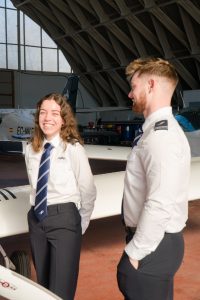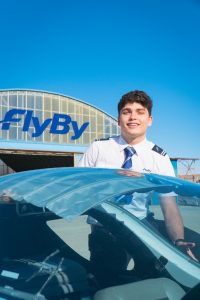On this page we are going to discuss the Type Rating. Perhaps you are coming towards the end of your flight school training and about to obtain your commercial pilot licence; maybe you haven’t started training but you are planning ahead, or someone may have mentioned the phrase Type Rating to you. We will clear up what a Type Rating is, what you can expect during the course and who needs a Type Rating.
What is a Type Rating?
A Type Rating is a course where you learn how to fly a specific aircraft type, for example a Boeing 787, Airbus A350, Embraer 190, etc. These are complex aircraft requiring months of training so that you know all of the systems and emergency procedures. Not only that, companies will often look to train you in their Standard Operating Procedures (SOPs) during a Type Rating. I will talk more about it later but this is one of the main reasons we suggest you do not do a Type Rating unless directed to do so by a company hiring you. SOPs are specific to each airline, many flight schools will have them too. They are in place to ensure their pilots are all operating from the same rule book, a rule book that has been approved as safe by the relevant authority.
During an ATPL course you will fly on small 2 or 4 seat aircraft as you learn the fundamentals of flying, aerodynamics and general aviation skills. Have a look at our fleet of modern aircraft here. Although it may seem like a tricky machine at the beginning, these aircraft are simple and many share the same features. Upon graduation, you will then need a Type Rating in order to fly a more complex aircraft. As you can imagine there is quite a significant difference between a Tecnam p2002 and a Boeing 737!
Details of the Type Rating
I did my 737 Type Rating in 2021 with an airline in Europe. It was a very rewarding but highly demanding course which many will tell you is harder than the ATPLs. My Type Rating took approximately 3 months to complete. Initially we had lessons on CRM (Crew Resource Management) along with talks about the company and what to expect. Then there was a period of self study. We were given A LOT of reading and online CBTs (Computer Based Training). These taught us about the various systems onboard the 737, from the hydraulics to the flight management systems as well as the various procedures for each stage of flight. I printed off posters and set myself up a paper cockpit in my spare room. I spent hours learning the various “flows” (sequences done by memory) so that I knew where all of the buttons and switches were until it became second nature to me.
After our period of self study, we went to the training department for two months for in person training. This started with multiple exams. We had to complete exams on the SOPs, Technical systems and also Performance calculations. We were also taken into mock cockpits where we were able to practise our flows with our Type Rating partners under the supervision of trainers. During a Type Rating you will be paired up with another student who you will fly with throughout the training. From now on you are going to be in a multi crew environment so get used to it! You will need to work as a team and cooperate to help each other through.
For the next two months you will be in the simulator. Usually you start on Fixed Base Simulators meaning the simulator does not have motion. You will gradually build up in complexity as you work through various scenarios with your partner under the instruction of an SFI (Synthetic Flight Instructor) or another senior trainer in the company. Eventually you’ll move on to the Full Flight Simulators which are full motion simulators. These are multi million euro machines which offer a very accurate representation of how the aircraft will react in real life. You’ll even feel the bumps as you taxi along and go over the taxi or runway lights! You’ll get to the end of your type rating and have an exam covering various things you’ve learned over the previous two months. It can be quite stressful, but trust in yourself and the training you’ve received. When you pass, you’ll move on to Base Training where you finally get your hands on the real aircraft for the first time and perform multiple touch and go’s. Essentially your Type Rating is now complete. As long as Base Training goes well, the airline will send you to one of its bases where your training will continue under the guidance of Training Captains for what is known as Line Training.
Can I do a Type Rating now and is it included in the ATPL?
All pilots need to start at the very beginning by completing their ATPL training with an ATO (Authorised Training Organisation). An ATPL is designed to take you up to the point where you are ready to apply and join airlines. The Type Rating is not a part of an ATPL course; usually it comes afterwards with a company that hires you, as I will explain later.
To be eligible to start a Type Rating you must have your (frozen) ATPL, have completed an MCC (Multi Crew Cooperation) course and have completed an A-UPRT (Advanced – Upset Prevention and Recovery Training) course. All of the above requirements are part of our All Inclusive ATPL training at FlyBy Aviation Academy and will be completed during your 14 months with us. When you graduate you will then be in a position to join an airline and complete a Type Rating with them.
Entering the job market as a brand new pilot can be a frustrating place. Some airlines ask for lots of experience, work permits for certain regions and you’ll also come across job adverts for “Type Rated pilots”. We strongly recommend waiting until you are hired by an airline until you complete a Type Rating. There are training companies that will offer you a Type Rating course. After a month or so not hearing back from airlines or feeling like you aren’t making progress it can be tempting. Many will tell you that it is a great way to stand out from other newly graduated pilots. Whilst this is true, there are significant downsides. Airlines are very particular about which training provider you have completed your Type Rating at. Some will have their own training department whilst others will work with one or two ATOs. If you have a Type Rating from a different ATO then they may refuse to accept it and require you to complete another Type Rating (including paying for any costs incurred).
If you do a Type Rating on a specific aircraft you are then limiting your options for future employment to airlines that fly that particular type of aircraft. If you went and did a Type Rating on an ATR but cannot then find a job with a company that flies the ATR you now have a worthless qualification. Bear in mind that a Type Rating is not cheap and will require renewing each year at your own expense if you haven’t found a company.
Imagine the situation. You graduate with your new ATPL but don’t get a job for a month or two so decide to get a Boeing 737 Type Rating. Then you hear about a new job advertisement: EasyJet is hiring. You send off all your documents and get through to the interview stage. So, why do you want to join us at EasyJet? Can you say that you’ve always wanted to fly for EasyJet despite getting a Type Rating for an aircraft that they don’t even own? Probably not a good idea! Also, if they think you are a good fit, they’ll hire you and you will need to complete a new Type Rating on an Airbus A320. These type ratings take a lot of time and money. Some as much as €30,000. Don’t waste your time and money on a Type Rating unless you know that you are going to be able to use it.
How much does a Type Rating cost?
The Type Rating will vary in cost depending on a few things. Firstly, what aircraft is the Type Rating on? Completing one on a jet (turbofan) aircraft will usually be more expensive than on a turboprop aircraft. The systems are more complex and the aircraft itself tends to be more expensive to run. Secondly it will depend which company you are joining. Here are some of the common contracts that pilots get when they are joining an airline and require a Type Rating:
- 100% paid for. Some airlines will cover the cost of the whole Type Rating. They will bond you to the airline for a period of time as you work for them and pay off the Type Rating cost through your salary.
- Percentage paid for. The airline will ask you to contribute towards your Type Rating costs and then cover the rest in a similar manner to option 1.
- Self funded. There are a few airlines that will require you to pay for 100% of the Type Rating. Not ideal, but if you have a contract with the airline it is a good way to get your foot in the door and banks are more likely to offer you a loan.
Please bear in mind that this can change and regularly does depending on the job markets. When airlines are facing a shortage of pilots, they have to make their employment packages more attractive with better conditions. This includes reducing the cost of Type Ratings for new pilots. Consider the rapid growth of the aviation industry and the industry recovery we saw after Covid. It’s likely you will be offered option 1 or 2 but we cannot say with certainty.
Hopefully this has cleared up what a Type Rating is for, what you can expect during a Type Rating and the options available to you. First thing’s first, sign up for our Integrated ATPL course and get great results. During our End to End coaching sessions at FlyBy a professional pilot will go through each step between graduation and sitting on the flight deck as a professional pilot. You will get hints and tips that have been learned first hand by recruitment experts and pilots who were recently in your position. Enjoy your ATPLs, the Type Rating is going to test you to your limits!



